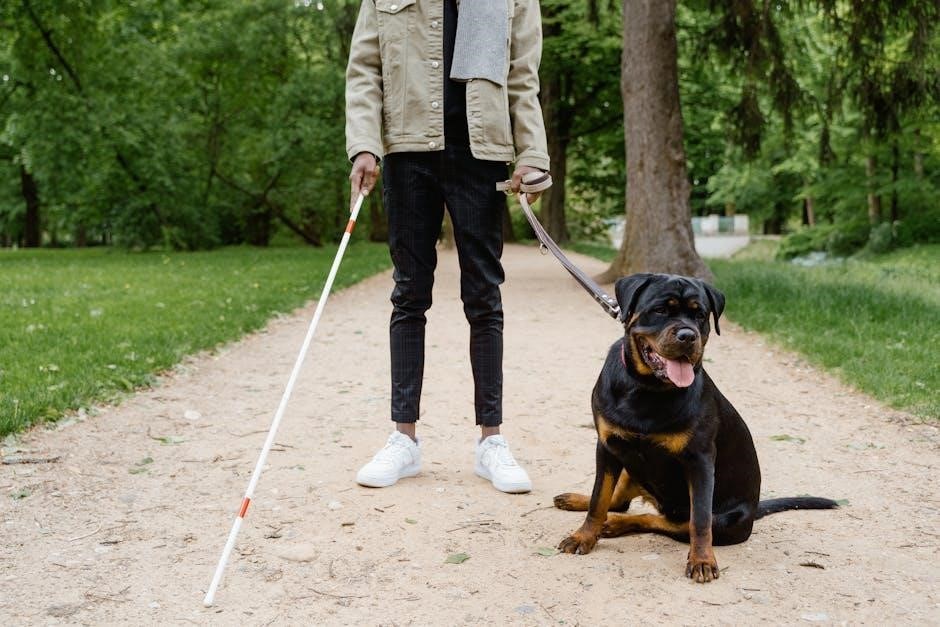A cystotomy is a surgical procedure involving an incision into the bladder‚ commonly performed in dogs to remove bladder stones or tumors‚ ensuring urinary health.
1.1 Definition and Purpose
A cystotomy is a surgical procedure involving a controlled incision into the urinary bladder. Its primary purpose is to access the bladder cavity‚ enabling the removal of obstructions such as stones‚ tumors‚ or other abnormal growths. This procedure is essential for diagnosing and treating bladder-related issues in dogs. By allowing direct visualization and intervention‚ a cystotomy helps restore normal urinary function and prevent complications like infections or obstruction. It is a critical intervention for maintaining urinary health and ensuring the well-being of canine patients.
1.2 Common Indications
A cystotomy is most commonly indicated for the removal of bladder stones‚ which are mineral clumps causing obstruction or discomfort. It is also performed to address bladder tumors‚ infections‚ or other growths. Additionally‚ the procedure may be necessary to relieve urinary blockages or to obtain tissue samples for diagnostic purposes. In cases where less invasive methods fail‚ a cystotomy provides direct access to the bladder‚ ensuring effective treatment. This surgery is critical for restoring urinary function and preventing complications in dogs with bladder-related issues.
Surgical Procedure Overview
Cystotomy involves a surgical incision into the bladder to address obstructions‚ infections‚ or growths. The procedure includes preoperative preparation‚ anesthesia‚ and precise surgical techniques to ensure success.
2.1 Preoperative Preparation
Preoperative preparation for canine cystotomy includes a comprehensive physical exam‚ blood tests‚ and imaging studies to assess the dog’s overall health and bladder condition. The veterinarian may also recommend fasting for 12-24 hours before surgery to minimize anesthesia risks. Additionally‚ any underlying health issues‚ such as urinary infections‚ are addressed beforehand to ensure the best surgical outcomes. Proper preparation helps reduce complications and ensures the dog is in optimal condition for the procedure.
2.2 Anesthesia and Positioning
General anesthesia is typically administered to ensure the dog remains pain-free and immobile during the procedure. The dog is positioned on its back‚ with legs secured to provide optimal access to the abdominal cavity. Monitoring of vital signs‚ such as heart rate and oxygen levels‚ is performed throughout the surgery. Proper positioning and anesthesia help minimize risks and ensure a smooth surgical process. The surgical site is then shaved and cleaned to maintain sterility‚ reducing the risk of infection.
2.3 Surgical Technique
A cystotomy involves making a surgical incision into the bladder to access the interior. Once the bladder is opened‚ the veterinarian uses sterile instruments‚ such as forceps and suction‚ to remove bladder stones or tumors. The procedure may also involve flushing the bladder to ensure all fragments are removed. After the obstruction or abnormal tissue is extracted‚ the bladder wall is carefully closed with sutures. A urinary catheter may be placed temporarily to monitor urine flow and ensure proper healing. The technique requires precision to minimize trauma and promote a successful outcome.

Postoperative Care and Recovery
Postoperative care involves monitoring for complications‚ managing pain‚ preventing infection‚ restricting activity‚ and ensuring proper wound healing and urinary catheter function.

3.1 Immediate Recovery and Monitoring

Immediate postoperative care focuses on closely monitoring your dog’s vital signs‚ such as heart rate‚ breathing‚ and temperature. Veterinary staff will observe for signs of bleeding‚ swelling‚ or discomfort at the surgical site. Pain management is prioritized to ensure your dog remains comfortable during recovery. Your veterinarian may use a urinary catheter to drain the bladder and monitor urine output. It’s crucial to keep the incision site clean and dry to prevent infection. Monitoring for any unusual behavior or signs of distress‚ such as vomiting or lethargy‚ is essential during this initial recovery phase.
3.2 Managing Pain and Infection Risk
Pain management is critical after a cystotomy to ensure your dog’s comfort and recovery. Veterinarians often use a combination of pain medications‚ such as opioids or NSAIDs‚ to alleviate discomfort. To reduce infection risk‚ the surgical site must be kept clean and dry. Your vet may prescribe antibiotics to prevent bacterial infections. Monitoring for signs of infection‚ such as redness‚ swelling‚ or discharge‚ is essential; Additionally‚ a urinary catheter may be used temporarily to monitor healing and prevent complications. Always follow your veterinarian’s instructions for medication and wound care to promote a safe and effective recovery.
3.3 Activity Restrictions
After a cystotomy‚ dogs must avoid strenuous activities to ensure proper healing. Restrict running‚ jumping‚ or climbing stairs for 7-14 days. Short‚ controlled walks on a leash are typically allowed. Overexertion can lead to complications‚ such as urinary leakage or reopening of the surgical site. Your vet may recommend confining your dog to a crate or quiet room to minimize movement. Monitoring your dog’s behavior and adhering to these restrictions is crucial for a smooth recovery. Follow your veterinarian’s specific instructions regarding activity levels to prevent setbacks and promote healing.
Potential Complications
Cystotomy may lead to surgical risks like infection‚ bleeding‚ or urinary leakage. Stricture formation and recurrence of bladder stones are also possible complications post-surgery.
4.1 Surgical Risks
Surgical risks during a cystotomy include bleeding‚ infection‚ or unintended damage to surrounding tissues. The bladder’s proximity to major organs increases the potential for complications. Postoperative infections or urinary leakage may arise if the incision site does not heal properly. Additionally‚ the manipulation of bladder tissue can lead to temporary or‚ in rare cases‚ permanent urinary dysfunction. Veterinarians take precautions‚ such as using sterile techniques and monitoring anesthesia‚ to minimize these risks. Despite these measures‚ pet owners should be vigilant for signs of complications‚ such as lethargy‚ inability to urinate‚ or discharge from the surgical site.
4.2 Postoperative Infections
Postoperative infections are a significant risk following a cystotomy. Bacterial contamination during surgery or improper wound care can lead to infection. Signs include redness‚ swelling‚ or discharge at the surgical site‚ fever‚ or lethargy. Urinary tract infections are also common due to catheter use or bladder manipulation. Veterinarians may prescribe antibiotics preemptively or treat infections as they arise. Monitoring for these signs and adhering to postoperative care instructions are crucial to prevent complications and ensure a smooth recovery.
4.4 Urinary Leakage or Stricture Formation
Urinary leakage or stricture formation are potential complications following a cystotomy. Leakage may occur if the bladder incision doesn’t heal properly‚ leading to urine escaping into the abdomen. Symptoms include swelling‚ pain‚ or moisture around the surgical site. Stricture formation involves narrowing of the urethra or bladder neck‚ causing obstructed urination. Diagnosis typically involves imaging studies or physical examination. Treatment may require additional surgery‚ catheterization‚ or other interventions to restore normal urinary function. Monitoring for signs like difficulty urinating or weak urine stream is essential to address these issues promptly and prevent long-term urinary tract damage.

Preventing Future Bladder Stones
Preventing future bladder stones involves dietary adjustments‚ regular veterinary check-ups‚ and monitoring urinary health. These steps help minimize the risk of recurrence and support overall urinary well-being in dogs.
5.1 Dietary Adjustments
Dietary adjustments play a crucial role in preventing bladder stones. Veterinarians recommend feeding dogs a balanced diet that minimizes mineral concentrations‚ such as calcium‚ magnesium‚ and phosphorus. Foods specifically formulated to reduce the risk of urinary stones are often prescribed. These diets help maintain optimal urine pH levels‚ preventing mineral crystallization. Additionally‚ ensuring adequate hydration by encouraging water intake is essential. Monitoring the dog’s food intake and avoiding supplements that could contribute to stone formation are also key strategies. Regular consultations with a vet ensure the diet remains effective over time‚ supporting long-term urinary health.
5.2 Regular Veterinary Check-ups
Regular veterinary check-ups are vital for maintaining urinary health and preventing bladder stone recurrence. These visits allow vets to monitor recovery‚ assess urinary function‚ and detect early signs of new stones. Urinalyses‚ imaging‚ and physical exams are common diagnostic tools used during these check-ups. Vets can also analyze previously removed stones to recommend tailored dietary adjustments. Consistent monitoring ensures any deviations from normal urinary health are addressed promptly. By scheduling regular appointments‚ dog owners can help prevent complications and ensure their pet’s long-term well-being‚ fostering a collaborative approach to managing urinary health effectively.
5.3 Monitoring Urinary Health
Monitoring urinary health post-cystotomy is essential to prevent recurrence of bladder stones and ensure proper healing. Owners should watch for signs like dysuria‚ hematuria‚ or increased urination frequency. Regular urinalyses and urine specific gravity tests can help detect imbalances. Dogs should be observed for any behavioral changes indicative of urinary discomfort. Routine bloodwork and imaging can also be used to assess overall urinary tract health. Early detection of abnormalities allows for timely intervention‚ reducing the risk of complications. Consistent monitoring ensures a smooth recovery and helps maintain long-term urinary well-being in dogs following cystotomy surgery.
